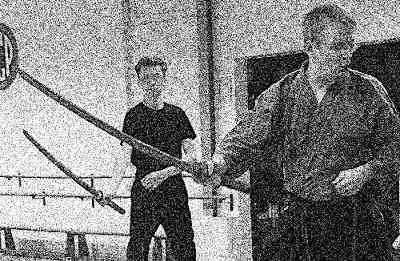Jump Start
As a beginner you are gret a wooden sword or bokken and make your first turns in the wide dojo air. After understanding the training environment, the complicated clothing, the kata learning system, the prospect of buying an Iaito, the training sword, is getting closer and closer. The questions remain unanswered, when should one get one, why not practice with such a training sword, etc.?
Price
From a monetary point of view it is clear: a wooden sword is much cheaper (e.g. 30€) than an Iaito (e.g. 500€), so it is of course an option to start with. You can also make mistakes during use without consequences (knocking on the ceiling when swinging back, touching the floor when hitting in a sitting position, etc.). The feeling is somehow blunt, but not comparable to a wooden stick. For many people, a Bokken feels unfamiliar in the hand (the handle has an oval shape), and the weight is quite demanding. The curve shape requires initial technical attention. There is up and down.
Technique
Technically speaking, practicing when switching from a bokken to an iaito becomes more complicated. A bokken is easier to swing. It forgives mistakes. When practicing Iaito, on the other hand, a beginner can only rarely produce the well-known cutting sound when hitting. This control of the correct cutting angle and execution of hand technique (Tenouchi) is sometimes frustrating. The learning curve increases in a number of ways compared to the wooden sword, mainly in correct technique execution.
- The sword must be drawn correctly (Nukiuchi), otherwise you will damage the scabbard (Saya).
- You don’t cut at will (Kiritsuke).
- The cutting angle must be right (Hasuji).
- Even holstering your sword (Noto) should be practiced diligently, otherwise you’ll poke your hand.
Responsibility
An iaito is considered a sporting weapon. Nevertheless, the ›device‹ is not harmless. When swinging, you can (unintentionally) stab with the tip. A cut wouldn’t be sharp, but it would still be effective. You maintain an Iaito, make sure that the wooden pin (Mekugi) is correctly seated, which saves the blade from flying away (that’s why you practice carefully in the dojo so that nobody stands in front of you). The most important thing: an iaito is reminiscent of a sharp sword, the katana. That’s why we treat the Iaito with respect. At some point you practice with a (dangerous) forged blade, why not start taking correct handling seriously now?
Benefit
The way of learning Iaido from Bokken – Iaito – Katana seems to be mapped out. Nevertheless, even as a practiced person you will practice with the bokken again and again, mainly in partner exercises. This gold standard makes it possible to check kata movements without a doubt and to explore alternatives. Correct distance ratios (Maai), position to the opponent (Enbusen, Seichusen) become clear. Researched even more strictly: do the kata (or my idea of the technique) actually work? This can be made clear (with caution, of course).
Conclusion
Bokken practice and Iaito use show multiple aspects of practice, and both are always useful. Here is a funny post from YouTube about it.
Why Iaito is preferred over the Bokken for Iaido training?
